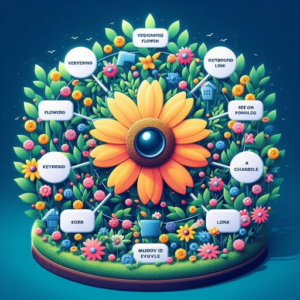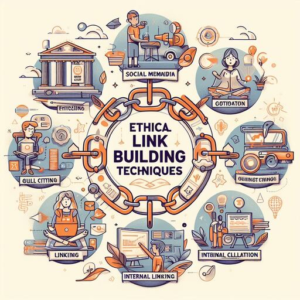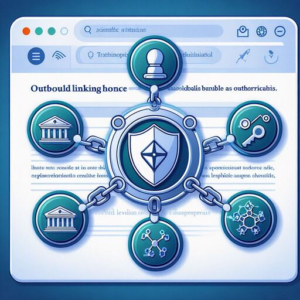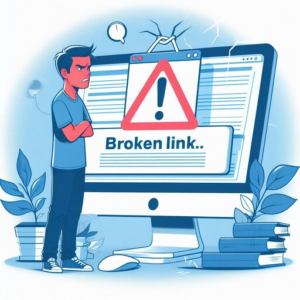In the vast expanse of the internet, links are the pathways that connect one webpage to another, guiding users through the digital landscape.
However, not all links are created equal. Sometimes, these pathways become fractured, leading users to dead ends known as broken links.
But fear not! In this comprehensive exploration, we’ll unravel the mystery of broken links, understanding what they are, why they occur, and most importantly, how to fix them.
Understanding Broken Links
A broken link, also known as a dead link or a 404 error, is a hyperlink that no longer functions as intended.
It’s like a road sign that promises a destination but fails to deliver, leaving users stranded in the vast online space. Broken links occur when the URL (Uniform Resource Locator) provided in the hyperlink is no longer valid or does not lead to the specified content.
Why Do Broken Links Occur?
Broken links can manifest for various reasons, each contributing to the digital puzzle of the internet’s complex architecture. These reasons include:

Website Restructuring:
When a website undergoes structural changes, such as the deletion of pages or updates to URLs, previously existing links may lead to non-existent destinations.
Content Removal or Relocation:
When content is removed or moved without proper redirection, it creates a challenge for linked pathways. Imagine it as roads suddenly changing course without clear directions.
In the digital world, this scenario renders the link obsolete, leading to a broken pathway. Users attempting to follow the link encounter a dead end, receiving an error message. To avoid this, proper redirection is essential.
It’s like installing detour signs, ensuring users smoothly navigate to the new location or relevant content.
Addressing content removal or relocation with redirection maintains the integrity of your website’s navigation, preventing users from hitting digital roadblocks.
Typographical Errors:
Typographical errors, those little mistakes in typing or formatting a URL, can have significant consequences. It’s akin to making a small typo in a street address, causing you to end up at the wrong place.
In the digital realm, these errors render the link invalid, resulting in a 404 error. When users click on a link, but it contains a typo, it’s like sending them to a location that doesn’t exist.
To ensure seamless navigation, meticulous attention to detail is crucial. Fixing these typographical errors is like correcting a misspelled address, ensuring users arrive at the intended digital destination without encountering any detours.
Expired Content:
Links directing to time-sensitive content, like event pages or promotions, face a potential hiccup when the content expires or becomes irrelevant.
It’s comparable to following a sign for an event that’s already concluded. The information is no longer valid.
In the digital landscape, links to expired or irrelevant content become broken, leading users to a dead end. To prevent this, regular updates and removal of outdated links are essential.
Think of it as removing expired signs and replacing them with directions to current and relevant destinations, ensuring users always find up-to-date and meaningful content.
The Impact of Broken Links
Broken links extend beyond mere inconveniences; they can have significant ramifications for both user experience and search engine optimization (SEO).
From a user perspective, encountering broken links disrupts the seamless navigation they expect, leading to frustration and a diminished perception of the website’s reliability. Furthermore, broken links can hamper the exploration of additional content.
On the SEO front, broken links signal to search engines that a website may be outdated or inadequately maintained, potentially resulting in lowered rankings. Moreover, broken links disrupt the flow of link equity, diminishing the website’s authority and credibility.
How to Fix Broken Links
Addressing broken links requires a proactive approach and a set of strategic solutions:
Regular Website Audits:
Regular website audits are crucial for a healthy online presence. Utilize tools like Google Search
Console or third-party link-checking software to conduct these audits. Identify and prioritize broken links for swift resolution.
This proactive approach ensures a seamless user experience and maintains your website’s credibility with search engines. Keep your digital space in top shape by consistently monitoring and fixing any broken links.
Redirects:
Implementing 301 redirects is a smart solution for broken links caused by content removal or URL changes.
This action not only guides users to the appropriate pages but also safeguards link equity, providing a notable boost to SEO efforts.
By seamlessly redirecting traffic, you ensure that users encounter relevant content and, simultaneously, maintain the integrity of your website’s link structure.
This strategic use of redirects contributes to a positive user experience while fortifying your site’s standing in search engine rankings.
Update Internal Links:
Maintain the health of your website by consistently updating internal links to align with structural changes or content updates.
This practice ensures that your URLs remain consistent and accurate, mitigating the risk of future broken links. By proactively managing internal links, you create a seamless navigation experience for users and contribute to the overall reliability of your site.
This simple yet effective measure plays a key role in preventing disruptions and enhancing the longevity of your online content.
External Link Monitoring:
Keep a close eye on external links directed to your website. Regularly monitor them to identify any broken links. If you discover any issues, proactively reach out to the webmasters of the respective websites, requesting updates or corrections.
This collaborative effort ensures the accuracy and functionality of external links, fostering a positive online ecosystem.
By actively managing these connections, you contribute to the seamless navigation of users across the digital landscape and maintain the credibility of your website in the broader online community.
Custom 404 Page:
Craft a personalized 404 error page that goes beyond the typical “page not found” message. Offer users helpful information and navigation options when they encounter broken links.
This thoughtful approach enhances the overall user experience by guiding visitors to alternative content and keeping them engaged.
A custom 404 page acts as a friendly guide in the digital landscape, turning a potential stumbling block into an opportunity for exploration.
By providing users with relevant information and alternative pathways, you not only mitigate the frustration of encountering a broken link but also encourage further interaction with your website.
Conclusion
In the dynamic world of the internet, broken links present a formidable challenge to website usability and SEO effectiveness.
By understanding the nature of broken links and implementing proactive solutions, website owners can enhance user experience, maintain search engine credibility, and ensure the seamless navigation of online content.
Addressing broken links is not just about technical integrity; it’s about fostering positive interactions with users and establishing trust in the ever-expanding digital landscape.
Check out our article on The Ultimate Guide to White Hat Link Building for a deeper dive into ethical link-building strategies.






